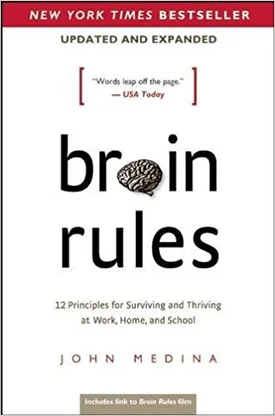Brain Rules: 12 Principles of Surviving and Thriving at Work, Home and School by John Medina
John Medina's Brain Rules, 12 Principals of Surviving and Thriving at Work, Home and School is a must-read book for anyone taking an interest in learning more on achieving success. Medina uses his extensive knowledge in neuroscience, evolutionary biology, psychology and education to show readers that the human brain is not a machine but rather a mystery, a difficult riddle that is constantly evolving. He explains evidence-based principles that not only reach into child development and learning but also touches on topics such as relationships, attention, and memory. Medina’s book is divided into twelve themes, exploring how the brain responds to stimuli, adapts to changing conditions, and learns in diverse situations.
The first theme of Medina’s Brain Rules is exercise. People often assume that a healthy lifestyle simply involves physical exercise, however the truth is that just as much importance needs to be placed on mental exercise. Old concepts of exercise providing only physical fitness has been overturned by recent research that shows that cognitive work also has major influence on the human body. Medina suggests we get into the habit of taking “stress breaks”, or short ten minute mental exercises, to help improve concentration and focus.
Secondly, Medina explains the role of sleep. Getting adequate amounts of sleep has a long-proven scientific and emotional benefit for both adults and children. Yet, society has overlooked this essential biological need in the midst of our ever-growing and increasingly busy lives. Medina’s advice is that “sleep well and prosper”, emphasizing the need for good quality sleep each day as best possible.
The third section of Brain Rules deals with the concept of “survival of the fittest”. According to Medina, this concept is one of the most misunderstood theories in biology, and is an even greater misconception when applied to workplace and school life. He argues that although competition may be healthy, it should not be added to a work environment. Rather, team work and collaboration will create a much better atmosphere for success.
Fourthly, Medina discusses the importance of focused attention. He asserts that multi-tasking is not efficient, and that people should instead focus on one task at a time. He states that if two tasks need to be done at one time, it is better to alternate between them twice a day, rather than taking both on at the same time.
The fifth section of Medina’s book discusses short term memory. He explains that the brain is able to retain information for a certain amount of time with a limited capacity, and that the best way to improve the capacity of the brain is by repeating the information during a certain amount of time.
The sixth section of Brain Rules is about repetitions and patterns. Medina states that the brain is always learning from feedback, and that positive and repetitive reinforcement is the key to effective learning. He argues that consistent repetition is much better for learning new information than randomly trying out different things.
The seventh section is about vision. Visually conveying data and information is much more efficient than any other means of communication, as it utilizes both the eyes and the brain. Medina suggests that providing visual reminders and cues are very helpful in retaining information.
The eighth section of Brain Rules is on the topic of emotions. Medina states that when expressing emotions, the most important thing is to remain authentic and true to oneself. He advises that no matter the situation, if a person remains objective and honest while understanding the emotional environment and making an effort to empathize with others, they will always be successful.
The ninth section of Brain Rules is on stress. Stress can negatively impact a person’s performance and decision-making, yet can be managed and controlled. Medina suggests that implementing good stress-management techniques will significantly help in making better decisions and increasing productivity.
The tenth section is about the importance of words. Medina asserts that the language and words we use can affect our behavior, and that modifying language can significantly improve our performance.
The eleventh section discusses spatial memory: the way an individual organizes, stores and presents physical space. Medina posits that effective architecture and design can greatly improve learning and organizational proficiency.
The last section talks about creative expression, which encompasses the ability to create something from nothing. It is a method of problem-solving and idea generation, and is essential for the success of any individual.
John Medina’s Brain Rules provides a glimpse into the complex workings of the human brain, diving into topics that were thought understood but are still not fully known. It is an invaluable read for anyone looking to take the next steps in their personal and professional development. By following Medina’s twelve principles, people can make more informed decisions, improve concentration, and adapt to changing environments more easily.

